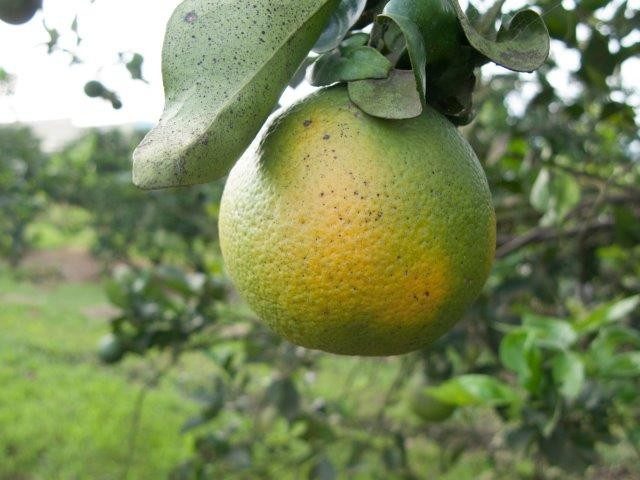FOR IMMEDIATE RELEASE | April 01, 2019
Juice plant pathogen could be treated with newly identified antibacterial agent
Note to journalists: Please report that this research will be presented at a meeting of the American Chemical Society.
A press conference on this topic will be held Tuesday, April 2, at 9:30 a.m. Eastern time in the Orange County Convention Center. Reporters may check-in at the press center, Room W231B, or watch live on YouTube http://bit.ly/ACSLive_Orlando2019 ("ACSLive_Orlando2019" is case sensitive). To ask questions online, sign in with a Google account.
ORLANDO, Fla., April 1, 2019 — There’s nothing like a glass of orange juice to start the morning off right, but prices have soared as the Florida citrus industry fights an epidemic that has reduced its yield by about half in the last 15 years. Citrus greening disease has been wreaking havoc, drying out juice oranges and reducing crop yield. The disease has no cure, but researchers report that they have now identified a fungal compound that may inhibit the causative bacteria.
The researchers will present their results today at the American Chemical Society (ACS) Spring 2019 National Meeting & Exposition. ACS, the world’s largest scientific society, is holding the meeting here through Thursday. It features nearly 13,000 presentations on a wide range of science topics.
Interestingly, this work got its start with a study on grapes. The team of collaborators, led in part by Katherine Maloney, Ph.D., was originally investigating potential cures for Pierce’s disease, which affects grapevines and has effects similar to those of citrus greening disease.
“Grapevines are clonally propagated,” says Maloney, who is at Point Loma Nazarene University. “In a vineyard, all the vines you see are genetically identical to each other.” By considering the identical plant genetics of commercial grapes, she and her team began to understand how some plants protected themselves from the Pierce’s disease pathogen (Xylella fastidiosa).
“In some vineyards, there are asymptomatic vines living directly next to vines that are diseased and symptomatic,” says Connor Brandenburg, an undergraduate researcher in Maloney’s laboratory. Since the plants’ genes couldn’t be responsible for these differences, the scientists knew there must be another organism that killed or suppressed the bacteria.
Collaborators at the University of California, Riverside examined the DNA of a collection of organisms found in or on the healthy vines. When they compared this to the DNA of the organisms from the sick vines, they found distinct differences. They isolated about a half dozen strains of fungi that inhibited the growth of the bacteria that causes Pierce’s disease. The Maloney lab then isolated metabolites from these fungi that the Riverside team tested for activity, looking for a compound associated with the fungi that could potentially act as an antibacterial treatment.
Radicinin, a molecule produced by one of the fungal strains, was isolated and purified by Maloney’s team. The molecule exhibited impressive potency for inhibiting bacterial growth in a laboratory experiment known as an agar diffusion assay. Because the bacteria that cause citrus greening disease, Candidatus liberibacter asiaticus, doesn’t grow in the laboratory, the researchers tested radicinin on a related bacteria called Liberibacter crescens.
“We know that radicinin is a product made by a specific fungus, and we have now determined a way to make it in the lab,” Brandenburg says. As he worked through radicinin’s synthesis, Brandenburg tested intermediate molecules against both bacterial diseases and found that they also stop propagation effectively. He is now evaluating all of the growth-inhibiting molecules to identify what they have in common so that those features could be exploited in a potential treatment.
According to Brandenburg, the next step for the team would be to identify a suitable formulation for delivery to grapevines and orange trees. The researchers say that although more experiments need to be done, moving these findings toward a real application could be a step closer to eradicating citrus greening disease and allowing citrus production to bounce back, lowering production costs and easing the strain on growers.
The researchers acknowledge support and funding from the California Department of Food and Agriculture and the U.S. Department of Agriculture-National Institute of Food and Agriculture Citrus Disease Research and Extension program.
The American Chemical Society, the world’s largest scientific society, is a not-for-profit organization chartered by the U.S. Congress. ACS is a global leader in providing access to chemistry-related information and research through its multiple databases, peer-reviewed journals and scientific conferences. ACS does not conduct research, but publishes and publicizes peer-reviewed scientific studies. Its main offices are in Washington, D.C., and Columbus, Ohio.
Media Contact
ACS Newsroom
newsroom@acs.org






